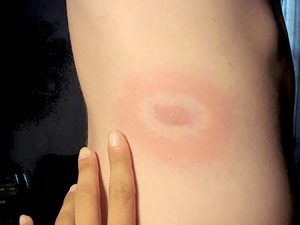By Judy O’Gorman Alvarez
A summer cold is an annoyance. But that low-grade fever and flu-like symptoms when air temperatures are high may be an indication of something more.
Monmouth County, where many ticks call home, ranked second in New Jersey of the 4,800 cases of Lyme disease in 2015.
According to the Centers for Disease Control and Prevention, Lyme disease is caused by the bacterium Borrelia burgdorferi and is transmitted to humans through the bite of infected blacklegged – or deer ticks.
Symptoms usually include fever, headache, fatigue and a skin rash, commonly called a bull’s eye rash. If left untreated, the infection can spread to joints, the heart and the nervous system.
Lyme disease is diagnosed based on symptoms, the appearance of a rash and the possibility of exposure to infected ticks. But often the patient doesn’t recall being bitten.
Lab tests to identify antibodies to the bacteria can help confirm the diagnosis. Most cases of Lyme disease can be treated successfully with a few weeks of antibiotics.
Deer ticks that transmit Lyme disease can occasionally transmit other diseases as well, including anaplasmosis, ehrlichiosis and Rocky Mountain spotted fever. All of them cause flu-like symptoms.
“In Monmouth County it is very endemic,” said Nasir Ahmad, M.D., infectious disease specialist at Meridian Medical Group. “We have the highest incidence of Lyme disease, especially in summer months.”
Ahmad warns that anyone living in this area who participates in outdoor activities should be aware. “Even in your backyard, you should be very careful,” he said. “Especially if you have deer in your backyard.”
After outings, parents should inspect their children’s bodies carefully and be sure to check themselves. Ticks can be found in hard to notice places, such as the back of the legs.
A tick must be embedded in a host’s skin for many hours to cause an infection. If it’s on clothing or merely crawling on skin, it’s unlikely to be an issue.
“If it’s engorged and it’s a deer tick,” said Ahmad, you may have been infected with Lyme disease.
“The tick bite is painless,” he said. “It leaves an anesthetic so it desensitizes the skin. Most patients don’t recall a tick bite.”
“Anyone who has flu-like symptoms in this area, especially in the summer months,” should think about their possible exposure to ticks.
And that telltale bull’s eye rash everyone talks about may not be present. “We only see that in less than 50 percent of cases” of Lyme disease, Ahmad said.

The first stage of Lyme’s disease is acute, when a patient has flu-like symptoms. If left untreated, it can reach the sub-acute stage and can affect the heart. “People can have a complete heart block,” said Ahmad. Often when prompted, the patient will remember they had flu-like symptoms weeks ago.
Ahmad has seen acute cases that resulted in Bell’s palsy, a condition where the muscles on one side of the face become weak or paralyzed. Many could assume this is a stroke symptom. “But stroke does not cause fever,” he said.
Ahmad may know better than most physicians about how symptoms of Lyme disease can be missed. A few years ago he was diagnosed with the disease.
“I had severe flu-like symptoms, but I ignored it,” he said.
“I was feeling very fatigued, woke up sweating with a low-grade fever and my joints were aching,” he said. “I thought I had rheumatoid arthritis.”
Although he could not recall an encounter with a tick, he tested positive for Lyme and started a course of antibiotics.
While his experience may have caused Ahmad to have more empathy for his patients with Lyme disease, it certainly illustrates the importance of taking a complete patient history. “Awareness is very important,” he said, “and especially in this area.”
This article was first published in the August 3 – 10, 2017 print edition of The Two River Times.














